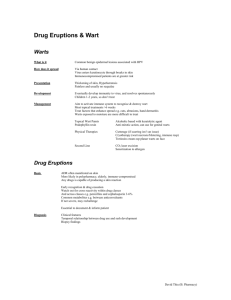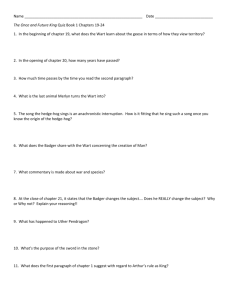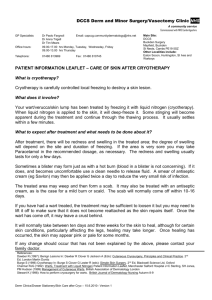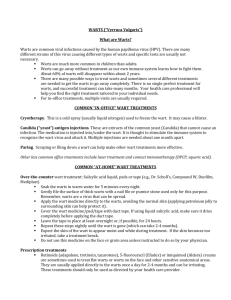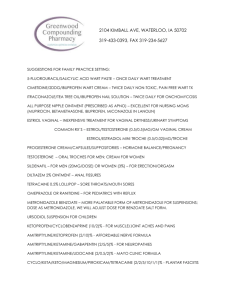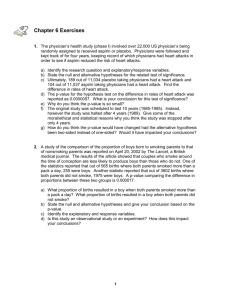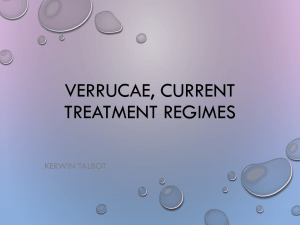Introduction What are the different types of warts? What Causes
advertisement
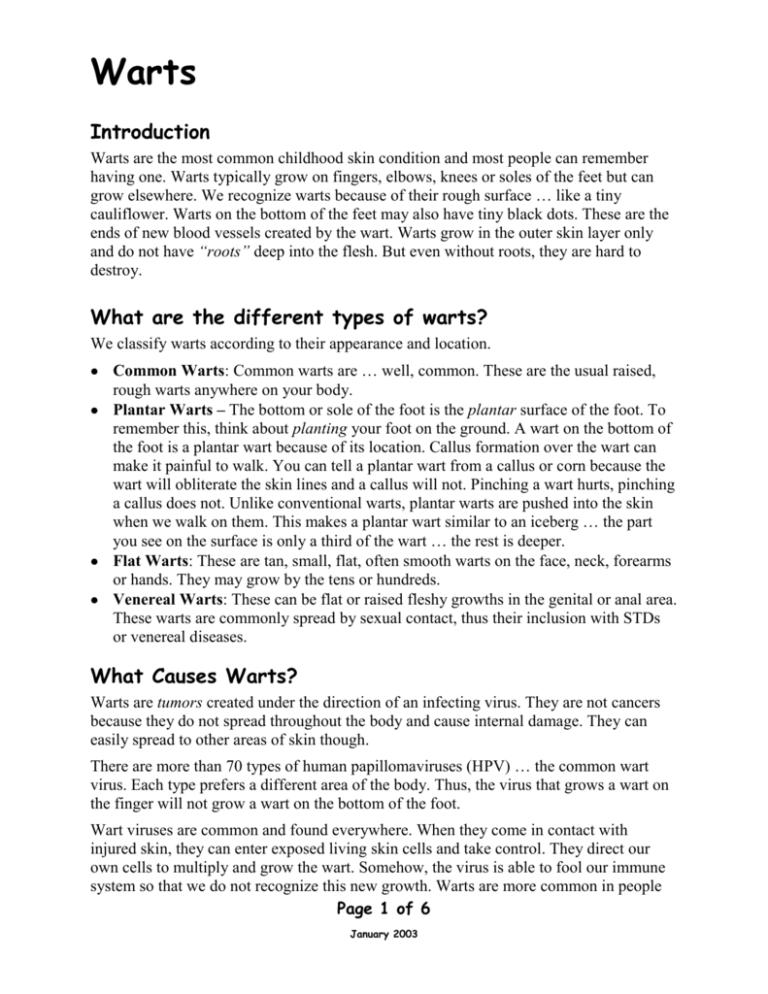
Warts Introduction Warts are the most common childhood skin condition and most people can remember having one. Warts typically grow on fingers, elbows, knees or soles of the feet but can grow elsewhere. We recognize warts because of their rough surface … like a tiny cauliflower. Warts on the bottom of the feet may also have tiny black dots. These are the ends of new blood vessels created by the wart. Warts grow in the outer skin layer only and do not have “roots” deep into the flesh. But even without roots, they are hard to destroy. What are the different types of warts? We classify warts according to their appearance and location. Common Warts: Common warts are … well, common. These are the usual raised, rough warts anywhere on your body. Plantar Warts – The bottom or sole of the foot is the plantar surface of the foot. To remember this, think about planting your foot on the ground. A wart on the bottom of the foot is a plantar wart because of its location. Callus formation over the wart can make it painful to walk. You can tell a plantar wart from a callus or corn because the wart will obliterate the skin lines and a callus will not. Pinching a wart hurts, pinching a callus does not. Unlike conventional warts, plantar warts are pushed into the skin when we walk on them. This makes a plantar wart similar to an iceberg … the part you see on the surface is only a third of the wart … the rest is deeper. Flat Warts: These are tan, small, flat, often smooth warts on the face, neck, forearms or hands. They may grow by the tens or hundreds. Venereal Warts: These can be flat or raised fleshy growths in the genital or anal area. These warts are commonly spread by sexual contact, thus their inclusion with STDs or venereal diseases. What Causes Warts? Warts are tumors created under the direction of an infecting virus. They are not cancers because they do not spread throughout the body and cause internal damage. They can easily spread to other areas of skin though. There are more than 70 types of human papillomaviruses (HPV) … the common wart virus. Each type prefers a different area of the body. Thus, the virus that grows a wart on the finger will not grow a wart on the bottom of the foot. Wart viruses are common and found everywhere. When they come in contact with injured skin, they can enter exposed living skin cells and take control. They direct our own cells to multiply and grow the wart. Somehow, the virus is able to fool our immune system so that we do not recognize this new growth. Warts are more common in people Page 1 of 6 January 2003 Warts with less mature immune systems. This is why children and adolescents are more susceptible. Eventually, the body’s immune system recognizes the wart and gets rid of it. This is why about 25% of warts disappear on their own within six months and 65% disappear within two years. When the wart disappears on its own, there is no scar. Some aggressive wart treatments though can leave scars. Should You Treat A Wart? Good question. You have a good chance that the wart will go away spontaneously with no treatment over the next two years. Warts are resistant to our best treatments. Most home wart treatments require discipline and perseverance. Most office-based treatments involve pain, repeated visits and expense. If the wart hurts, spreads or looks unsightly, most people will choose to treat the wart. Just keep in mind that warts usually go away on their own and the treatment may be worse than the disease! What Can I do At Home? Since there is no one effective way to get rid of a wart, there are many home remedies. These are difficult to judge because at any time your immune system may “wake up” and get rid of the wart. Whatever you did prior to the disappearance of the wart will forever live in your memory as the cure. Digging up a new potato and rubbing it on the wart under a full moon might work but it is hard to prove. The most common over-the counter (OTC) remedy is aspirin! That’s right, salicylic acid is a mild skin peeler and is sometimes combined with other acids such as lactic acid. Apply as a liquid or in a patch nightly for 12 weeks. Some common brands are Dr. Scholl’s Clear Away, Tinamed, Compound W, Duofilm, Duoderm and Mediplast. In addition, most major pharmacy chains have their own generic brand. Each night, soften the wart by soaking it in warm water for 5-10 minutes. A wet wart absorbs the acid better. Apply the product. If it is a liquid, cover with a Band-Aid. If it is a patch, just apply the patch. Remove the patch or Band-Aid the next morning. The wart will turn white. File away the dead skin with a pumice stone or emery board. If the area becomes sore then omit the nightly treatment for a while until the skin starts to heal. Diabetics don’t heal well so they probably should avoid these products. How effective is this home remedy? Studies show that salicylic acid is as effective as many of the treatments we do in the office … but again … no wart treatment is perfect. Page 2 of 6 January 2003 Warts Duct Tape! Yes, the common household sticky thick tape was reported in October 2002 to work better than freezing with liquid nitrogen. To use this technique: Apply the duct tape directly over the wart for six days. Remove the tape and soften the wart by soaking in warm water for 20 minutes. Buff the wart down with an emery board or pumice stone. Reapply the tape for another six days. Why does this work? Again the immune system is thought to play its role. The heavy, gooey tape irritates the wart and prompts the immune system to recognize the foreign virus. The cure rate for duct tape in the study was 85% versus only 60% for liquid nitrogen. Probably the best cure rates are with OTC salicyclic acid covered with duct tape. What Treatments Do Doctor’s Use? Most medical treatments for warts follow one principle … destruction. We can use any one of several methods to destroy the infected wart tissue. Which treatment depends upon the wart's location, its size, your previous response to wart treatment, what we have available, cost, your preference, side effects, and the time available to complete treatment. Treatment will generally be repeated until the warts disappear. Liquid Nitrogen - The most common method in our office is cryotherapy … freezing or “frost biting” the wart with liquid nitrogen. We store liquid nitrogen at -195.6 degrees C (-320 F !!) in a large vacuum bottle. We apply the nitrogen with a cotton- tipped applicator dipped into the tank. The wart initially turns white and then resumes its normal skin color followed by redness and inflammation. You will feel intense cold or a burning sensation. Depending on the location being frozen, the pain can be mild, moderate or severe. Later, the area may blister up. It is necessary to repeat the treatment every 1-2 weeks until the wart goes away. Paradoxically, sometimes the treatment seems to “anger” the wart and it grows bigger. Usually cryotherapy leaves little or no scar but there are risks. Our melanocytes (the skin cells that make pigment) are easily killed by the intense cold. Thus, the skin may change color. In lighter skinned people, the area turns white. In darker skinned individuals the area may become inflamed and darker. In areas directly over bone, the skin may atrophy or thin. Underlying superficial nerves can be damaged. To reduce the pain of cryotherapy, apply an OTC anesthetic lidocaine cream such as EMLA or ELA-Max 30 to 60 minutes before your treatment. Also take Tylenol or Advil. Page 3 of 6 January 2003 Warts The American Academy of Family Physicians handout on warts contains this advice: You must do some things on your own at home to get the wart ready for removal. Doing these things before you come to your doctor's office can reduce the number of freezing treatments you need. You should do the following: Every night for 2 weeks, clean the wart with soap and water and put 17% salicylic acid gel (one brand name: Compound W) on it. After putting on the gel, cover the wart with a piece of 40% salicylic acid pad (one brand name: Mediplast). Cut the pad so that it is a little bit bigger than the wart. The pad has a sticky backing that will help it stay on the wart. Leave the pad on the wart for 24 hours. If the area becomes very sore or red, stop using the gel and pad and call your doctor's office. After you take the pad off, clean the area with soap and water, put more gel on the wart and put on another pad. If you are very active during the day and the pad moves off the wart, you can leave the area uncovered during the day and only wear the pad at night. What happens next? After 2 weeks of this treatment, your wart will have turned white and will look fluffy. Your doctor will then be able to remove the white skin layer covering the wart and use cryosurgery to freeze the base (root) of the wart. If your skin reacts strongly to cold, tell your doctor before cryosurgery. Caustic chemicals – Some physicians use bichloracetic acid, nitric acid, cantharidin or other blistering agent. This achieves the same effect as liquid nitrogen. Electricity – Some physicians will burn warts off with an electric device but this should be done with special ventilation to prevent inhaling the virus. Podophyllin - (25% resin in tincture of benzoin). This is applied by the physician to venereal warts. This is left on up to six hours and then washed off. Other options include surgical removal of the wart and superpulsed carbon-dioxide-laser vaporization. These are not done in our office. Even though we try to destroy the bulk of the wart, some viruses are undamaged and the wart grows back. Besides destroying wart tissue, these methods may “wake up” the immune system which then destroys the wart. Without a healthy immune system, the wart may remain. Page 4 of 6 January 2003 Warts Are There Treatments That Don’t Rely on Destruction? There is one topical prescription treatment that stimulates the immune system. Imiquimod Cream (trade named Aldara) is approved for venereal warts only, but works for regular warts too. This known as an off-label use … that is … the FDA prevents drug companies from marketing the drug for regular warts but it is not dangerous to do so. We use drugs for such off-label uses daily. Apply the 5% cream 3 nights per week. Wash off after 6 to 10 hours. Use for a maximum of 16 weeks. This is probably the best treatment for widespread warts. It comes in a box of 12 single use packets (one month supply) at the cost of about $130 per box. Not cheap. Aldara is not indicated for use in children. Has Anything Else Been Tried? Of course! It was reported in the August 2002 British Medical Journal that placebos have a 30 percent cure rate after ten weeks. Now you see why it is so hard to evaluate wart treatments. Hypnosis and self-suggestion also work one third of the time and are particularly effective in children. Why? Is this just placebo? As discussed above, your immune system needs to be involved to get rid of the wart. Hypnosis can active the immune system. One source for this handout was a physician who uses the following: “ 'Charming warts' is particularly effective with children, and is discussed in leading medical textbooks I've had success with dabbing warts with paint and letting children watch them glow under a black light! For added impact, I've sometimes pressed a painted wart onto a piece of filter paper to make a spot, and then burned the paper. I tell the child it will fall off in two weeks - and it does!” Cimetidine (trade name Tagamet) was the first of the stomach acid suppressing drugs. This has been used for resistant warts in adults and molluscum contagiosum in children (another viral skin infection). It has a mild immune enhancing effect, … but may be no more effective than placebo. This is available over the counter and taken in a dose of 200 to 400 mg, two or three times per day for two to three months. Tagamet can interact with coumadin, dilantin and theophylline. It can cause the male breast to swell if used for a long time. Page 5 of 6 January 2003 Warts Alternative Medicine Since the medical treatments for warts are less than perfect, there are many alternative medicine and folklore treatments for warts. These apply to common warts and not cervical or genital warts. Do they work? I don’t know! Aloe – Crush up the plant or use a commercially available cream or gel. Apply daily. Lemon oil – Put one drop of lemon (essential) oil directly on the wart. Milkweed – Squeeze the white sap from milkweed onto the wart or use topical creams. Dandelion sap– This one has been used for years. Apply the sap directly to the wart or put a dandelion flower in your shoe under the wart. Garlic – Crush or slice up a garlic clove and apply to the wart overnight for seven nights. Vitamin C – Take Vitamin C powder, make a paste and apply nightly for one to two weeks. Banana – Tape a piece of a banana peel to the wart overnight for one to two weeks. Closing Remark Mark Twain offered this quaint solution … "Why, you take your cat and go and get in the graveyard 'long about midnight when somebody that was wicked has been buried; and when it's midnight a devil will come, or maybe two or three, but you can't see 'em, you can only hear something like the wind, or maybe hear 'em talk; and when they're taking that feller away, you heave your cat after 'em and say, 'Devil follow corpse, cat follow devil, warts follow cat, I'm done with ye!' That'll fetch ANY "wart." Summary Warts are viral infections. Warts can be very hard to get rid of. Decide if the treatment is worse than the disease. You can probably do as well on your own with OTC salicyclic acid as we do with liquid nitrogen. Page 6 of 6 January 2003
